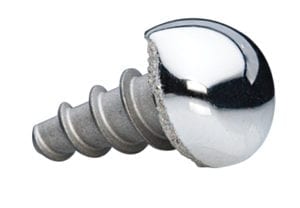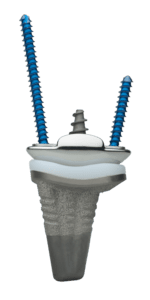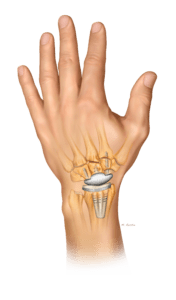Wrist Implants
WristMotion® Hemiarthroplasty & Total Arthroplasty Systems

Have you been told that you suffer from degenerative arthritis of the wrist? Did you know that traditional treatments can limit a person’s range of motion and ability to perform daily tasks? Or, that they can also restrict physical activities that require grip, strength and wrist rotation
The WristMotion® Hemiarthroplasty Implant System restores mobility and recreates your natural anatomy while treating Wrist Arthritis and SNAC and SLAC Wrists. The WristMotion® System is performed in conjunction with a PRC (Proximal Row Carpectomy) and unlike traditional treatments, the Arthrosurface WristMotion® Hemiarthroplasty Implant System can allow you to live an independent lifestyle by preserving the native anatomy of your joint and removing minimal bone. It consists of a cap and mating fixation component that allows the surgeon to restore only the damaged area of the joint, without removing excessive bone and tissue.
It is the only implant designed to create a new, mobile wrist joint by matching the shapes and contours of the patients’ existing joint surfaces. The dual curved implant is placed into the capitate bone (main bone in the middle of the hand) and creates a smooth articulation with the socket of the radial bone (the large wrist bone in the forearm).
The wrist is a complex joint with many small “ball and socket” joints that move against each other. When the wrist becomes arthritic or the cartilage is damaged, pain and function between the different bones can severely limit activity and grip strength. The two most common procedures are a Proximal Row Carpectomy (PRC) or a 4 corner fusion. The fusion procedure is straightforward. The goal is to immobilize the bones in the hand thereby eliminating the pain caused by motion. However, it will affect the normal function and movement of the wrist joint. A PRC consists of removing the row of small damaged bones closest to the forearm so that the arthritic and painful elements are taken out. The hand bones naturally realign themselves so that the wrist can move normally and pain free again. The limitation with a PRC surgery is that it’s only indicated for a very narrow group of patients, namely, those where the damage or arthritis is limited to the bones in the proximal row. Patients tend to prefer the ability to move their wrist so Arthrosurface designed the WristMotion® implant to resurface the main bone in the second row allowing more patients to get a motion preserving PRC procedure. According to the literature, 4 Corner Fusions have a larger number of associated complications which is another reason that a PRC procedure is more attractive. By using a HemiCAP implant to recreate a new functional joint the patients can now maintain their motion and stay active.
WristMotion® Total Wrist Arthroplasty System
 The WristMotion
The WristMotion ® TWA System, is a modular joint preservation system that replaces both the radial and carpal sides of the wrist joint for patients suffering from rheumatoid arthritis, osteoarthritis, or post-traumatic arthritis. The system incorporates Arthrosurface’s proven fixation technology in the central carpal taper post design, also used in the WristMotion Hemiarthroplasty system, which has been in clinical use since 2015, with over 2,600 cases performed to date1. This system design is intended to address the concern of carpal loosening as it relates to existing systems on the market today. The WristMotion System also utilizes the Company’s dual curvature design feature in the carpal implant combined with the dorsal flange (or hood) which allows for greater range of extension due to the increased implant surface area1. Preclinical robotic testing has demonstrated that the combination of these features provides exceptional range of motion and rotational freedom (often called “dart thrower’s motion”), consistent with the Company’s design philosophy of preserving the complex kinematics of the native joints1. The WristMotion TWA System, along with the WristMotion Hemiarthroplasty device, provides surgeons with multiple treatment options for different stages and severities of wrist osteoarthritis.
® TWA System, is a modular joint preservation system that replaces both the radial and carpal sides of the wrist joint for patients suffering from rheumatoid arthritis, osteoarthritis, or post-traumatic arthritis. The system incorporates Arthrosurface’s proven fixation technology in the central carpal taper post design, also used in the WristMotion Hemiarthroplasty system, which has been in clinical use since 2015, with over 2,600 cases performed to date1. This system design is intended to address the concern of carpal loosening as it relates to existing systems on the market today. The WristMotion System also utilizes the Company’s dual curvature design feature in the carpal implant combined with the dorsal flange (or hood) which allows for greater range of extension due to the increased implant surface area1. Preclinical robotic testing has demonstrated that the combination of these features provides exceptional range of motion and rotational freedom (often called “dart thrower’s motion”), consistent with the Company’s design philosophy of preserving the complex kinematics of the native joints1. The WristMotion TWA System, along with the WristMotion Hemiarthroplasty device, provides surgeons with multiple treatment options for different stages and severities of wrist osteoarthritis.
The system is designed to replace the radiocarpal joint (distal radius and proximal row of carpal bones) and is intended to alleviate pain while restoring functionality and mobility of the joint.
